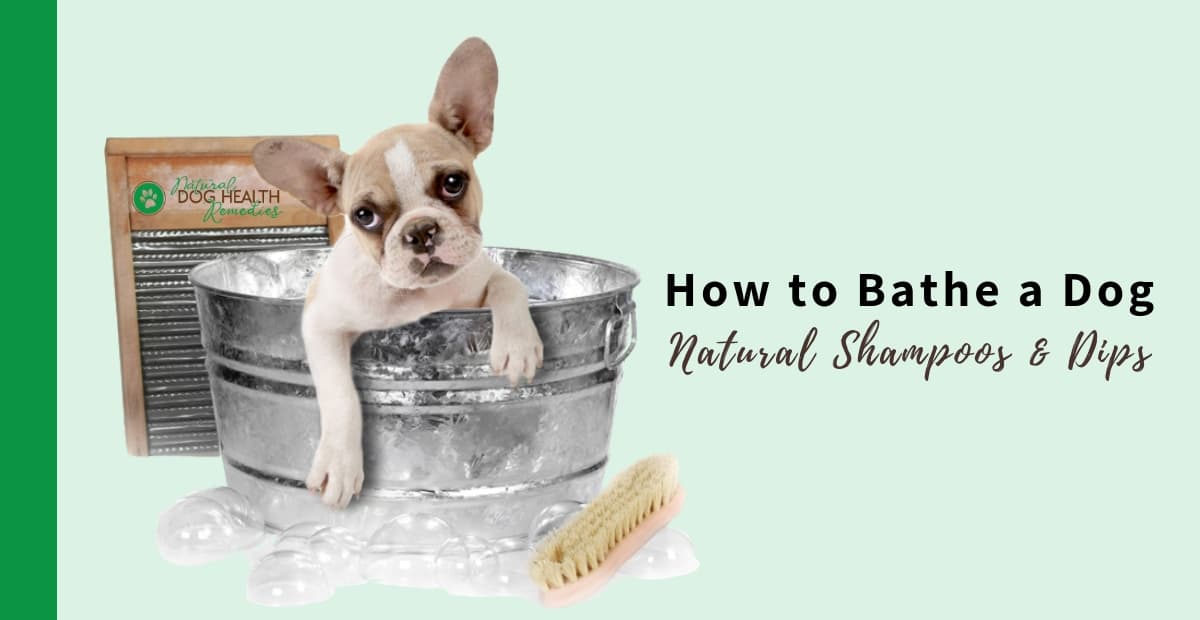Bathing a Dog
(FTC Disclosure: If you make a purchase via a link on this page, I may receive a small commission, at no added cost to you.)

Overview
Many dog parents think that dogs do not like taking a bath.
However, if done right, most dogs actually do not mind taking a shower or bath - and some even enjoy it a lot.
The most important thing is to train your dog to like taking a bath and to make the bathing experience less scary and stressful and more enjoyable!
This article covers these topics:
- Why Dogs Hate Baths & What You Can Do
- Preparing to Bathe Your Dog
- How to Bathe a Dog at Home
- How Often Should You Give a Dog a Bath?
- Choosing the Right Shampoo
- Three Natural Dips for Itchy Skin
- Can I Give a Dog a Bath Without Water?
Why Dogs Hate Baths & What You Can Do
Here are some reasons why dogs do not like taking a bath and what you can do:
| Reasons | What You Can Do |
| They were not properly introduced to the idea of bathing |
|
| They do not like the slippery bathtub floor |
|
| They do not like soap in their eyes |
|
| They do not like water in their ears |
|
| They do not like cold water |
|
| They do not like the high-pitched sound of the hairdryer |
|
| They do not like the combing after the bath because the hair is tangled |
|
Things to Prepare Before Bathing a Dog
Here are some things that you need to give your dog a nice and relaxing bath:
- A non-skid surface or bath mat: As mentioned above, some dogs dislike bathing because the bathtub is slippery and they cannot get a steady footing. This can be fixed by simply putting a bath mat in the tub.
- Correct shampoo: Some dog shampoos are harsh and may be irritating to the dog's skin. Be sure to get some natural and gentle doggie shampoo. Do not use shampoos for people on your dog.
- Washcloth for the face: Dogs do not like having water on their face especially in their eyes. Have some washcloths ready to wipe off the water that may have gotten into their eyes and use the washcloth to clean the dog's face.
- Drying towels: If you have a big dog or a dog that has long hair, you definitely need more than one drying towel!
- Treats: Place treats strategically so you can offer them to your dog during the bath.
8 Easy Steps to Bathe a Dog at Home
Tip #1: If you have a young dog full of energy or a high-strung dog, exercise your dog before giving him a bath to tire him out.
Tip #2: If you are trying to re-educate your dog about the "fun" of bathing, use treats. Put treats where you can easily get to while bathing your dog and reward him when he behaves well during the bath.
Here's how to bathe a dog:
- Put your dog in the bathtub or sink.
- Run the water and make sure that it is warm but not too hot.
- Wet the hair around the neck and apply shampoo to the neck first, then proceed to do the same all the way to the tail. If you start from the neck, fleas cannot jump from the body to the head.
- While applying shampoo, gently massage the skin and haircoat. You can leave the shampoo on for 10 minutes or so to kill any fleas.
- In the meantime, use a soft washcloth to clean the dog's face and ears.
- Returning to the body, gently massage and scrub the whole body to remove dead skin and dirt. Pay particular attention to the armpits, belly, all the way down the legs, and the paws and toes.
- Rinse thoroughly. This is important because if you don't rinse off all the shampoo, your dog's skin will get dry.
- Towel dry.
If you choose to use a blow dryer to dry your dog's hair, use it on the lowest setting and keep moving the blow dryer around to avoid irritating any particular area of the skin.
How Often Should You Give a Dog a Bath?
 Some dog parents think that bathing makes a dog's skin dry and flaky. Don't worry. It doesn't. In fact, in most cases, the dog's skin actually improves if bathed on a regular basis AND if the correct shampoo is used.
Some dog parents think that bathing makes a dog's skin dry and flaky. Don't worry. It doesn't. In fact, in most cases, the dog's skin actually improves if bathed on a regular basis AND if the correct shampoo is used.
Bathing is in fact a very good skin therapy for dogs with itchy and inflamed skin because by bathing and rinsing the coat, you are manually removing toxins and allergens from your dog's skin.
For dogs with skin allergies or with greasy coats, veterinarians suggest that frequent bathing is beneficial - as often as twice a week.
The bottom line? So long as you use a good shampoo, you can feel comfortable bathing your dog as often as is necessary - from once a week to once a month.
One easy way to decide when to have a bath is to observe your dog. If your dog starts scratching himself (i.e. starts feeling itchy) and his skin starts getting smelly and greasy, then a bath is definitely in order.
Choosing the Right Shampoo
Choosing the right shampoo for your dog is important, and remember, never use human shampoos on your dog. Human shampoos are designed for a more acidic skin with many sweat glands and are often too harsh for dogs' skin.
Choose a natural dog shampoo that best meets the needs of your dog's skin conditions. Here are some suggestions (Affiliate links):
- Natural Soothing Dog Shampoo
If your dog has no skin problems and you just want to use a gentle shampoo that is soothing, then here is one for you to try:
This shampoo contains skin soothing and nourishing ingredients such as colloidal oatmeal, shea butter, kelp serum, and jojoba oil. Both the shampoo and conditioner are 100% free of sodium lauryl sulfate (SLS), sodium laureth sulfate (SLES) and paraben.
This herbal shampoo contains no Sodium Laurel Sulfate. Instead, it contains Aloe Vera, which is soothing, and coconut oil, which is anti-bacterial and anti-inflammatory, as well as lots of herbal oils that nourish the coat. Your dog's coat will be soft and supple and he will smell great as well!
- Dog Shampoo for Dry Skin
If your dog has truly dry skin, try this natural oatmeal shampoo:
This shampoo contains colloidal oatmeal which is is simply oats ground into an extremely fine powder. It can draw out or soothe irritants and can be used for dryness and dandruff.
- Dog Shampoo for Sensitive and Inflammed Skin
Dogs with sensitive, greasy and inflammed skin due to allergies can benefit from a natural anti-inflammatory shampoo such as this one:
This natural shampoo contains no artificial fragrance or colorings and is hypoallergenic. The shampoo can help speed the healing of itchy, inflammed skin and hot spots.
Three Natural Dips for Dog Itchy Skin
If you have a dog who is prone to skin irritations and inflammation, these natural dips are beneficial. Use any of these AFTER shampooing and rinsing your dog:
- Organic Apple Cider Vinegar: Add one cup of organic ACV to one gallon of water. Pour the mixture on your dog starting from the neck behind the ears all the way down the back (avoid the head and face). Rub it into the skin and towel dry (do not rinse). ACV is anti-fungal and anti-bacterial and can also deodorize smelly dogs.
- Lemon: Slice up a whole lemon and boil it in a quart of water. Let the water cool down to room temperature and remove the lemon slices.
Pour the lemon water on your dog starting from the neck behind the ears all the way down the back (avoid the head and face). Rub it into the skin and towel dry (do not rinse). This dip can make your dog smell really great!
Note, however, that if your dog has a black coat, lemon can bleach the coat when your dog goes out in the sun. Therefore, if you don't want your black dog's coat to have red "highlights", avoid this dip.
- Povidone Iodine (Betadine): This is a medicated dip for dogs with recurrent skin problems, such as hot spots and yeast infections.
Povidone iodine is an organic iodine solution that is anti-fungal and anti-bacterial. It is non-toxic and safe for use on dogs. You can get Betadine at any drugstore or online.
Mix one cup of Betadine with one gallon of water. Pour the solution on your dog starting from the neck behind the ears all the way down the back (avoid the head and face). Rub it into the skin and towel dry (do not rinse).
Can I Give a Dog a Bath Without Water?
Sometimes it is just not possible to give your dog a bath. For example, maybe your dog is sick, or you are traveling with your dog, or you are just too busy...
That doesn't mean you can't keep your dog relatively clean and smelling nice!
In between baths, you can definitely give your dog a "bath" without water:
- Brush Your Dog: First, groom your dog by brushing him from top to bottom! This can prevent his hair from matting (especially if you have a dog with long hair), and can get rid of dirt and dust trapped in the hair. The brushing can also stimulate circulation and distribute sebum evenly.
- Use Doggie Wipes: Then, you can use doggie wipes such as these Earthbath Moist Towel Grooming Wipes for Dogs
to wipe down your dog. Pay attention to crevices and creases (e.g. "armpits", under the tail, around the anus), and don't forget the paws.
- Use a Natural Spray: If your dog is not smelling particularly "fresh", use a natural spray to help add a pleasant scent to your dog. I like to make a spray using essential oils, but you can definitely get one from the store, like Only Natural Pet Pure & Clean Deodorizing Spray
.
Visit this page to find out what causes a dog to feel itchy.





